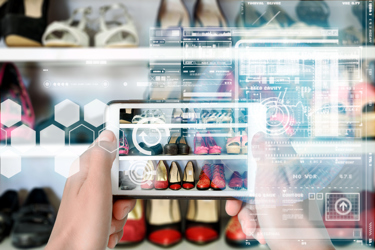How VNTANA Is Helping Save Retail With Augmented Reality
By Vanessa Liu, SAP.iO Foundries North America

In mere months, COVID-19 propelled us five years into the future when it comes to digital adoption, according to global consulting firm McKinsey.
You can see this playing out across industries. Restaurants are improving online ordering and delivery capabilities. Telehealth is increasingly available for patients who need it. Online learning has become a mandatory option for students of all ages. On and on and on.
“Digital trends were already picking up steam,” said Ashley Crowder, CEO and cofounder of VNTANA. “But COVID-19 has brought everything to the fore now. What used to be a nice-to-have is now a must-have.”
A Transformative Digital Impact
83.1 million U.S. consumers are using augmented reality (AR) every month, according to eMarketer.
“We’re talking about 25% of the population,” Crowder said. “This is a golden opportunity for companies to capitalize on a growing user base.”
Not only is AR’s prevalence unavoidable, but its effects on customer decision making and satisfaction are also undeniable.
- 40% higher conversion rates overall from 3D and AR shopping (Threekit)
- 72% of consumers purchased items they weren’t planning on buying due to AR (ThinkMobiles)
- 40% of consumers would pay more for a product they can customize in AR (U.S. Census Bureau)
There are more numbers like these, but they all tell a similar story: 3D and AR enable companies to better meet customer needs, facilitates confident buying decisions, and increases post-purchase satisfaction.
“Every retailer should be using 3D and AR,” Crowder said. “That has nothing to do with VNTANA’s business. That’s just a fact.”
Empowering The AR Future
Until recently, it simply hasn’t been reasonable or cost-effective for companies to develop customer-facing 3D models of their products at scale.
Sure, most companies already have 3D models for manufacturing purposes. But 3D software and formatting can vary widely, and the corresponding files are typically too big (and not formatted correctly) to easily drop into augmented reality on a desktop or mobile device. 3D artists need 3-5 days to optimize and convert any given product, which can cost a company $2,500 or more every time.
That’s where VNTANA comes into play. VNTANA creates and distributes 3D files at scale — seamlessly integrating with any company’s preexisting design process. With its software and cloud-based content management system (CMS), VNTANA enables customers to provide revolutionary 3D and AR e-commerce experiences at scale.
Rather than 3-5 days, it takes an average of 30 seconds to enable a product for 3D web and AR using VNTANA. The average monthly cost per product is less than $4. Files are automatically compressed — using the company’s patented optimization algorithms — to as little as 2% of their original size while maintaining high visual fidelity.
How does it look? Check it out yourself by scanning the QR code below:

Plugging And Playing
VNTANA began developing mixed reality experiences — often for brands at large sporting events or expos like SXSW — in 2012. At the time, mass adoption of the technology wasn’t there yet.
“Back then, phones weren’t capable of incorporating the experiences we could create, so we focused on location-based experiences,” Crowder said.
During their early work, the VNTANA team noticed clients never had the 3D file capabilities necessary to execute on the VR and AR experiences. That’s when they began developing the software to automatically optimize and distribute 3D files at scale. They quickly realized it was valuable in more ways than one.
“Allowing companies to use existing manufacturing design files and 3D scans to instantly create the 3D files needed for web, AR, VR, and advertising platforms like Facebook and Google Swirl helps make the technology more affordable and more scalable for businesses everywhere,” Crowder said.
The CMS offers a 3D web viewer with built-in AR as well as a plug and play ability to share 3D files to customer e-commerce sites. Today, VNTANA has nearly 20 customers operating on the enterprise 3D solution. Adidas launches thousands of products a year on it, Cotton, Inc. has digitized all its textiles in the platform, and Shah Luxury has digitized more than 5,000 pieces of jewelry.
VNTANA also has partnered with SAP so that any SAP Commerce Cloud user can seamlessly use VNTANA software on their e-commerce sites. The company plans to continue adding configuration and customization options to its software as the months and years go on.
Crowder said the software can be used in practically any retail space, including furniture, apparel, footwear, home goods, medical devices, and more.
“Every single industry is moving to 3D because it provides customers with a better understanding of the product,” she said. “The use cases are endless.”
About The Author
Vanessa leads SAP.iO Foundries in North America, which are SAP’s accelerators for B2B enterprise startups. She has earned degrees in neuroscience and law, and is a champion for social justice and tireless advocate for under-represented business startups, especially those led by women or diverse founders.
